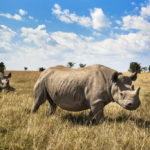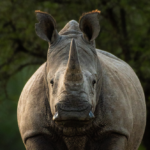Our grant-making policy
Save the Rhino International focuses on Key 1 and Key 2 populations of Critically Endangered rhinos (currently black, Sumatran and Javan), with the long-term aim of the species being down-listed to a lower category of threat in the IUCN Red List. Save the Rhino maintains close relations with its field partners to maximise its technical knowledge and ability to ensure that resources are delivered to the points of greatest need; actively raises funds to disburse to field programmes; facilitates international collaboration and the dissemination of best practice; and actively communicates with key audiences to promote understanding of and support for rhino conservation.
Save the Rhino works with specific field programmes or partner organisations on a long-term basis:
- Kenya: the Association of Private and community Land Rhino Sanctuaries (and its sub-projects: 51 Degrees Ltd, the Emergency Fund for black rhinos, the APLRS Administrator, the Laikipia rhino range expansion project, and the ForRangers initiative); Borana Conservancy; Lewa Wildlife Conservancy; and Ol Jogi Conservancy
- Zambia: North Luangwa Conservation Programme; Lolesha Luangwa, the environmental education program run by NLCP; and Nsumbu-Tanganyika Conservation Project
- Zimbabwe: Lowveld Rhino Trust
- Namibia: the Ministry of Environment and Tourism; Save the Rhino Trust
- South Africa: Hluhluwe-iMfolozi Park; uMkhuze Game Reserve
- Africa: IUCN SSC African Rhino Specialist Group (and its sub-projects: meetings, Pachyderm and Secretariat); the Rhino Resource Center
- Indonesia: Javan Rhino Study and Conservation Area; Rhino Protection Unit programme; and the Sumatran Rhino Sanctuary
- Vietnam: Education for Nature-Vietnam; TRAFFIC-Vietnam
- China: The Environmental Investigation Agency; TRAFFIC-China
Very occasionally, Save the Rhino makes grants to other organisations whose work overlaps with its priority field programmes, e.g. Wildlife Crime Prevention, based in Zambia.
We provide grants according to our seven strategic priorities. Below sets out in detail what these mean for eligibility criteria for future grantees.
Objective: To protect rhinos through law-enforcement activities at site level, and support intelligence gathering and analysis to pre-empt and prosecute poaching and trafficking of rhino products
Activities: Anti-poaching operations; Intelligence and investigations (in range states); Rhino operations (e.g. de-horning); and Translocations (to reduce poaching threats).
Priority programmes and partners:
- Kenya: The APLRS (51 Degrees Ltd); Borana Conservancy; Lewa Wildlife Conservancy; Ol Jogi Conservancy
- Zambia: North Luangwa Conservation Programme; Nsumbu-Tanganyika Conservation Project
- Namibia: the Ministry of Environment and Tourism
- South Africa: Hluhluwe-iMfolozi Park; uMkhuze Game Reserve
- Indonesia: Javan Rhino Study and Conservation Area; Rhino Protection Unit programme
Ineligible:
- NB: Save the Rhino is not looking to expand the range of field programmes supported
- Field programmes involving privately owned rhinos
- Research and development costs for new technology (hard- or software) to protect rhino populations unless the request comes from and is prioritised by one of the field programmes already supported
Objective: To implement effective biological and ecological management and monitoring of rhino populations and their habitats to achieve optimum population growth rates
Activities: Conservation breeding (Sumatran rhino only); Habitat management; Range expansion; Rhino monitoring; Rhino operations (e.g. ear-notching, collaring); Rhino-sighting data management; Translocations (for genetic management); and Veterinary interventions
Priority programmes and partners:
- Kenya: The APLRS (Emergency Fund for black rhinos, the Laikipia rhino range expansion project); Borana Conservancy; Lewa Wildlife Conservancy; Ol Jogi Conservancy
- Zambia: North Luangwa Conservation Programme
- Zimbabwe: Lowveld Rhino Trust
- Namibia: the Ministry of Environment and Tourism; Save the Rhino Trust
- South Africa: Hluhluwe-iMfolozi Park; uMkhuze Game Reserve
- Indonesia: Javan Rhino Study and Conservation Area; the Sumatran Rhino Sanctuary
Ineligible:
- NB: Save the Rhino is not looking to expand the range of field programmes supported
- Rhino programmes that have non-viable populations, i.e. fewer than 20 unrelated founders, except for the Sumatran Rhino Sanctuary, which is an essential part of the Conservation strategy for the recovery of the Sumatran rhinoceros in Indonesia 2015-2020
- Intensively-managed or captive rhino populations, except for the Sumatran Rhino Sanctuary
- The hand-rearing of rhino calves, except for those injured, wounded or orphaned at field programmes already supported, and which are to be released back into the wild when weaned
- Ex situ rhino conservation efforts, including extra-limital populations (i.e. managed as an exotic species)
Objective: To reduce trade in illegal rhino products via better law enforcement in consumer countries and promoting behaviour change by consumers and the closure of markets encouraging poaching
Activities: Behaviour-change campaigns; Consumer and market research; Intelligence and investigations (in consumer countries); and Strengthening legal and policy frameworks
Priority programmes and partners:
- Vietnam: Education for Nature-Vietnam; TRAFFIC-Vietnam
- China: The Environmental Investigation Agency; TRAFFIC-China
Ineligible:
- Demand reduction work that is not targeted at a key consumer group or important influencer, i.e. Save the Rhino will not fund campaigns aims at, for example, school children in Viet Nam
- Behaviour-change campaigns that don’t follow a recognised social marketing methodology or conduct monitoring and evaluation into the impact of the campaign
- Projects that focus on campaigning against issues e.g. sustainable use, that conflict with Save the Rhino’s position on the issue(s)
Objective: To ensure that rhino conservation professionals are appropriately skilled and trained
Activities: Ranger training (site level); Ranger welfare; Research dissemination; and Workshops and training (multi-agency)
Priority programmes and partners:
- Kenya: the APLRS (the For Rangers initiative); Borana Conservancy; Lewa Wildlife Conservancy; and Ol Jogi Conservancy
- Zambia: North Luangwa Conservation Programme
- Namibia: the Ministry of Environment and Tourism; Save the Rhino Trust
- South Africa: Hluhluwe-iMfolozi Park; uMkhuze Game Reserve
- Africa: IUCN SSC African Rhino Specialist Group (Pachyderm); the Rhino Resource Center
Ineligible:
- Save the Rhino does not fund research projects, unless they are focused on the specific populations that Save the Rhino already supports, and regarded as a priority for funding by the relevant field programme manager
- Field trips for students or volunteers
Objective: To improve coordination within and between rhino range state conservation agencies and professionals
Activities: Continental coordination; and National strategy development and implementation
Priority programmes and partners:
- Kenya: the APLRS (APLRS Administrator, the Laikipia rhino range expansion project)
- Africa: IUCN SSC African Rhino Specialist Group (and its sub-projects: meetings, Pachyderm and Secretariat)
Ineligible:
- Umbrella groups or initiatives that do not involve any of the field programmes that Save the Rhino currently supports
Objective: To engage with multiple stakeholders in rhino range states in accordance with the equity triangle of recognition, procedure and distribution
Activities: Community incentives (linked to rhino population performance); Environmental education (black rhino-focused); and Targeted community engagement
Priority programmes and partners:
- Kenya: the APLRS (the Laikipia rhino range expansion project)
- Zambia: Lolesha Luangwa, the environmental education program run by the North Luangwa Conservation Programme
- Zimbabwe: Lowveld Rhino Trust
Ineligible:
- NB: Save the Rhino is not looking to expand the range of field programmes supported
- Environmental education programmes that do not focus on the rhino, or which do not have strong monitoring and evaluation in place
- Community development work that is not explicitly linked to rhino population performance at the associated site
- Other organizations’ costs of awareness raising about rhino conservation issues
Objective: To explore and develop sustainable financing mechanisms and structures to fund priority rhino conservation efforts
Activities: Technical support (e.g. support for Rhino Impact Investment Project); and Applying to multi-year funders
Priority programmes and partners:
- All those supported by Save the Rhino on a long-term basis
Ineligible:
- Other organisations’ fundraising campaigns




